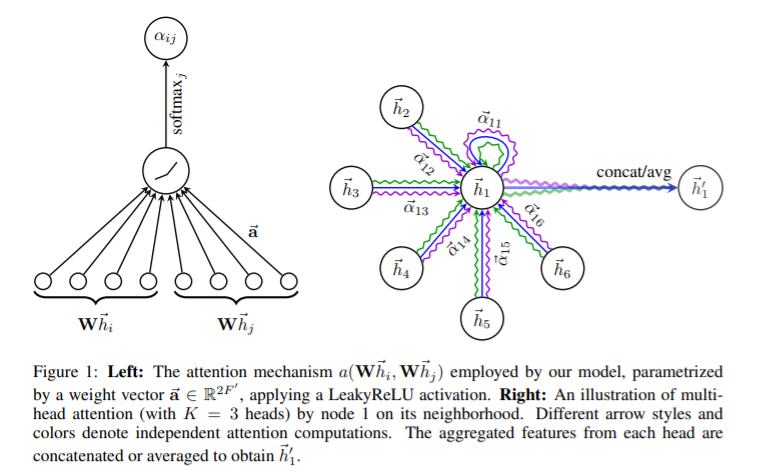Graph Attention Networks (2017, 2820)
Contents
- Abstract
- Introduction
- GAT architecture
- Graph Attentional Layer
0. Abstract
GAT (Graph Attention Networks)
- leveraging masked self-attentional layers
- address the shortcomings of prior methods based on graph convolutions
- stack layers, in which nodes are able to attend over their neighborhoods’ features
- enable (implicitly) specifying different weights to different nodes in a neighborhood,
- without requiring any kind of costly matrix operation
- without depending on knowing the graph structure
1. Introduction
- introduce an attention-based architecture to perform node classification of graph-structured data.
- Key idea :
- compute the hidden representations of each node, by attending over its neighbors, following a self-attention strategy
- attention
- (1) parallelizable
- (2) can be applied to graph nodes having different degrees by specifying arbitrary weights to the neighbors
- (3) directly applicable to inductive learning problems
2. GAT architecture
building block layer
- used to construct arbitrary graph attention network

(1) Graph Attentional Layer
INPUT : set of node features
- \(\mathbf{h}=\left\{\vec{h}_{1}, \vec{h}_{2}, \ldots, \vec{h}_{N}\right\}, \vec{h}_{i} \in \mathbb{R}^{F}\).
- \(N\) : # of nodes
- \(F\) : # of features
OUTPUT : new set of node features
- \(\mathbf{h}^{\prime}=\left\{\vec{h}_{1}^{\prime}, \vec{h}_{2}^{\prime}, \ldots, \vec{h}_{N}^{\prime}\right\}, \vec{h}_{i}^{\prime} \in \mathbb{R}^{F^{\prime}}\).
- \(N\) : # of nodes
- \(F'\) : # of new features
ATTENTION
- at least one learnable linear transformation is required
- Shared linear transformation : \(\mathbf{W} \in \mathbb{R}^{F^{\prime} \times F}\)
- applied to every node
- self-attention :
- \(e_{i j}=a\left(\mathbf{W} \vec{h}_{i}, \mathbf{W} \vec{h}_{j}\right)\).
- \(a: \mathbb{R}^{F^{\prime}} \times \mathbb{R}^{F^{\prime}} \rightarrow \mathbb{R}\).
- “IMPORTANCE” of node \(j\)’s features to node \(i\)
- MASKING : mask all NON-neighbors
- (this paper) use \(a\) as FFNN, parameterized by \(\overrightarrow{\mathbf{a}} \in \mathbb{R}^{2 F^{\prime}}\)+ LeakyReLU
- \(\alpha_{i j}=\operatorname{softmax}_{j}\left(e_{i j}\right)=\frac{\exp \left(e_{i j}\right)}{\sum_{k \in \mathcal{N}_{i}} \exp \left(e_{i k}\right)}\).
- \(\alpha_{i j}=\frac{\exp \left(\operatorname{LeakyReLU}\left(\overrightarrow{\mathbf{a}}^{T}\left[\mathbf{W} \vec{h}_{i} \mid \mid \mathbf{W} \vec{h}_{j}\right]\right)\right)}{\sum_{k \in \mathcal{N}_{i}} \exp \left(\text { LeakyReLU }\left(\overrightarrow{\mathbf{a}}^{T}\left[\mathbf{W} \vec{h}_{i} \mid \mid \mathbf{W} \vec{h}_{k}\right]\right)\right)}\).
- \(e_{i j}=a\left(\mathbf{W} \vec{h}_{i}, \mathbf{W} \vec{h}_{j}\right)\).
- Result (final output features) for every node
- (1-head) \(\vec{h}_{i}^{\prime}=\sigma\left(\sum_{j \in \mathcal{N}_{i}} \alpha_{i j} \mathbf{W} \vec{h}_{j}\right)\).
- \(\mathbf{h}^{\prime}\) consists of \(F^{\prime}\) features
- (multi(K)-head + concatenate) \(\vec{h}_{i}^{\prime}= \mid \mid _{k=1}^{K} \sigma\left(\sum_{j \in \mathcal{N}_{i}} \alpha_{i j}^{k} \mathbf{W}^{k} \vec{h}_{j}\right)\)
- \(\mathbf{h}^{\prime}\) consists of \(K F^{\prime}\) features
- (multi(K)-head + average) \(\vec{h}_{i}^{\prime}=\sigma\left(\frac{1}{K} \sum_{k=1}^{K} \sum_{j \in \mathcal{N}_{i}} \alpha_{i j}^{k} \mathbf{W}^{k} \vec{h}_{j}\right)\)
- in the final layer
- \(\mathbf{h}^{\prime}\) consists of \(F^{\prime}\) features
- (1-head) \(\vec{h}_{i}^{\prime}=\sigma\left(\sum_{j \in \mathcal{N}_{i}} \alpha_{i j} \mathbf{W} \vec{h}_{j}\right)\).
